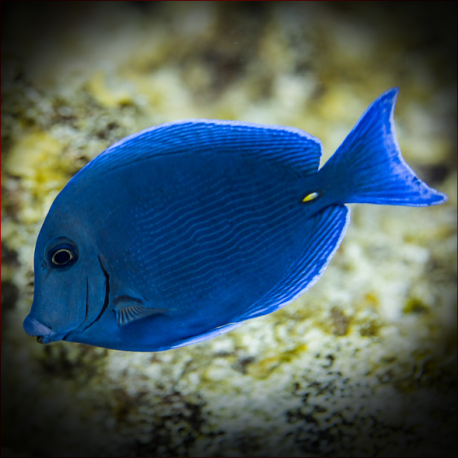More info
Datasheet
| Minimum Tank Size | 900 litres / 237.75 US gallons |
| Maximum Size | 35cm / 13.78inches |
| Reef Compatible | Always reef safe |
| Temperament | Might be aggressive towards similar species |
| Temperature | 22.2°C / 71.96°F - 25.6°C / 78.08°F |
| Specific Gravity | 1.020-1.025 |
| Carbonate Hardness | 8-12 |
| pH | 8.1-8.4 |
General Description
The Blue Caribbean Tang, scientifically known as Acanthurus coeruleus, is a member of the Acanthuridae family. These fish are commonly referred to as Blue tang, Blue doctor, Blue doctorfish, Blur tang, or Blue surgeonfish. They are characterized by their vibrant blue coloration and a disc-shaped body with a sharp spine near the caudal fin.
Aquarium Suitability
The Blue Caribbean Tang is suitable for most aquarium setups. However, they may exhibit aggression towards similar species, so it is advised to introduce them last in a tank with other fish. These fish require a minimum tank size of 900 liters and ample space for swimming.
Demands, Care, and Hardiness
The Blue Caribbean Tang has average hardiness but is sensitive during transportation and acclimatization. They thrive in a well-established aquarium with plenty of algae for grazing. It is essential to feed them algae-based foods like seaweed and spirulina to maintain their immune system. Hiding places are crucial, especially when introducing them into a new environment.
Reef Suitability
The Blue Caribbean Tang is always reef safe and rarely bothers corals or invertebrates. However, large Palettes/Blue tangs can sometimes cause disturbances in a reef tank.
Aquarium Setup
When setting up an aquarium for Blue Caribbean Tangs, provide ample hiding spots, a well-maintained environment with rocks for algae grazing, and a minimum tank size of 900 liters. Ensure the water parameters are within the range of pH 8.1-8.4, temperature between 22.2-25.6°C, and specific gravity of 1.020-1.025.
Behaviour
Blue Caribbean Tangs are active swimmers that spend most of their time grazing on algae from rocks and stones. They may establish a hierarchy if kept with multiple tangs in the same tank.
Feeding and Diet
Their diet mainly consists of small crustaceans, but they primarily feed on algae. Offering macroalgae like seaweed or nori and microalgae such as spirulina is essential for their health.
Habitat and Distribution
Blue Caribbean Tangs are found in the Western Atlantic from New York, USA, and Bermuda to the Gulf of Mexico and Brazil. In the Eastern Atlantic, they are known to inhabit Ascension Island. These fish prefer warm waters and are commonly found in the Mexican Gulf.
Dimorphism and Captive Reproduction
The Blue Caribbean Tangs exhibit no significant dimorphic differences, and information on captive reproduction is not specified in the provided data.

